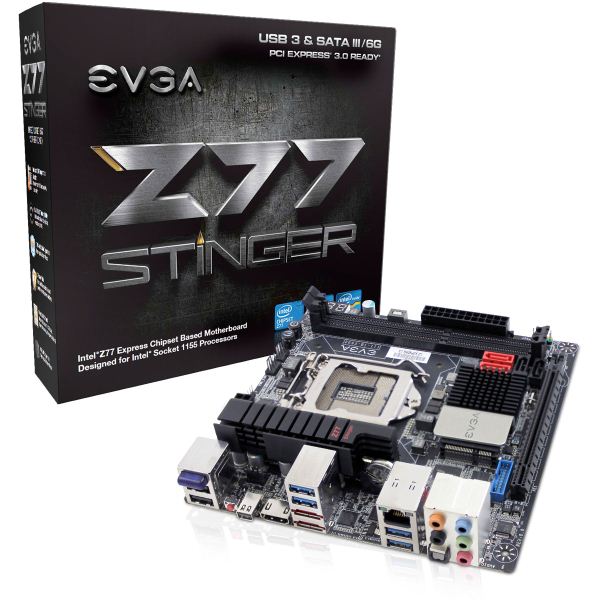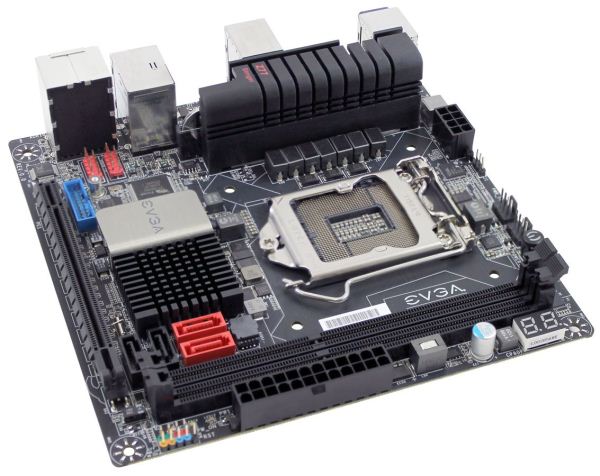Z77 mITX Round-Up: Five of the Best – MSI, Zotac, ASRock, EVGA and ASUS
by Ian Cutress on December 31, 2012 7:00 AM EST- Posted in
- Motherboards
- MSI
- ASRock
- EVGA
- ZOTAC
- Asus
- Ivy Bridge
- Z77
- mITX
EVGA Z77 Stinger Conclusion
EVGA has a reputation for being something a little special. The fan base is loyal, and despite the size of the company they have upgrade paths for their hardware (the EVGA Step-Up program) and deal with all RMA requests personally rather than through the reseller. The forums are always full of posts, and a lot of members also contribute their hardware and spare time for distributed computing projects such as Folding@Home or BOINC. EVGA’s main product line is in NVIDIA graphics cards, and their high end models, although expensive, are often pre-overclocked and sell like hot cakes. They hire top well-known overclockers to showcase how capable their products can be in the right hands.
The motherboard side is less lucrative. EVGA’s market share in the motherboard segment is tiny compared to ASUS and Gigabyte, and still small compared to MSI and Biostar. For a given chipset they rarely release more than three motherboards (e.g. X79 SLI, X79 FTW, X79 Classified or Z77 FTW, Z77 Stinger), and those motherboards are often late to launch and come with some easy-to-spot issues. Every so often they come out with something special (EVGA SR-2) which is hard to ignore.
When I approached EVGA to request a review sample of the Stinger, I had seen the leaked images online and it looked like a good product. I even posted them on AnandTech. When the sample came through the door and I saw the price, I was a little taken aback. $200 puts it as the most expensive mITX board on the market, even more so than the ASUS P8Z77-I Deluxe which uses a daughter PCB for power delivery. At the $200 price point, it was going to be a tough sell to all but EVGA enthusiasts.
For the green we get some ‘extra’ compared to most other mITX boards on the market. This means an Intel NIC, a total of six USB 3.0 ports, two more SATA 6 Gbps (in the form of eSATA), the socket placed at the top rather than the bottom, three fan headers and power/reset buttons with a debug LED. Unfortunately, most of the cheaper boards offer better audio than the Realtek ALC889, they offer a WiFi module included in the product, more video output connectivity, some offer an mSATA, a mini-PCIe, and substantially more IO on the back panel.
BIOS wise EVGA is at a disadvantage due to the size of the company, but the lack of XMP options in the release BIOS does not help much. Despite the two years since graphical BIOSes came into force, I have been told that an implementation may be coming with Haswell (and hopefully with a print screen option). The software side with EVGA also falls against the same hurdle, with only one utility that offers little – no BIOS update feature, no fan control, no network control, no power delivery control.
In terms of performance, all is right with the EVGA Z77 Stinger. We got a fair representation across the range of benchmarks with no out-of-the-ordinary bursts or dips apart from the 192 kHz audio test fail due to the ALC889.
As mentioned before, the EVGA Z77 Stinger is a hard sell, and at $200 it is not really doing itself any favors when compared side-by-side with the competition. There are motherboards out there that offer a lot more in terms of usability and experience, but with EVGA we do get that Step-Up program and direct dealing with RMA. Are these differences worth the $50-$55 jump up from an ASRock or an MSI? If the Z77 Stinger was around the same price as the Zotac, it might be worth a punt.












54 Comments
View All Comments
Sabresiberian - Tuesday, January 1, 2013 - link
Thanks for the great comparison review!It looks like there is a little mistake in the spec list for the Asus board, which shows it having a mini-PCIe connector. I would love it if it did, but I didn't see it on the board and it isn't mentioned in other spec lists.
It is important to me because I would ideally need connection for both a graphics card and a sound card (which I believe I could do through a mini-PCIe to PCIe x1 adapter if needed). This makes the EVGA Stinger the choice for me here, though the Asus board is the one I would prefer to buy.
I am truthfully a little disappointed in the EVGA board, which seems all too common with EVGA products in general these days. Great support is still there, but I'd rather they build bleeding edge components and not have to find out whether or not their support is as good as people say it is. The Stinger is a good board to be sure, and the Intel LAN alone puts it in the category of "will buy" for me, but I was hoping it would be something that would match or beat the Asus P877-I, and it just doesn't.
Foeketijn - Tuesday, January 1, 2013 - link
When you take overclocking out of the equation, B75 has it all, for the price just a tiny bit north of the old H61 chipset. Support for IB features (1600Mhz DDR3, PCI-e 3.0), Native Sata III, USB 3.0.It wasn't intended for the DIY market but fits the bill perfectly in my opinion. Only the very very few who need to OC, +16Gb ram or multiple SSD's @ full 6 Gb/s need the Z77 chipset.
The only thing is, that us mere mortals can't predict is, if a much cheaper chipset is used, did the OEM also cheapskate on the critical parts to? I would love to see some in-depth component analysis which I see for example, when a PSU is taken apart.
Which components are used? how well is the soldering done, does it still work at a sauna lanparty, etc.
I might be alone in this, but I would find that much more valuable information than all the performance benchmarks together (race to the bottom, be dammed!).
Including the northbridge in the CPU made motherboard and CPU reviews so predictible (or borring).Since then, I'm only interested in stability, ease of installation (nicely covered) and practical use (fan controll, MEM compatibility ect).
<offtopic> Oh I loved the XP-m 2500+ siverpainting 2001 era where you actually could get a noticeable improvement of performance and not necessarily have to sacrifice stability or risk bankruptcy</offtopic>
vanwazltoff - Tuesday, January 1, 2013 - link
i picked up an asus p8z77-i deluxe/wd before christmas and made a beast gaming computer out of it with an i5-3750k OCed to 4.5ghz and a gtx670 =]vanwazltoff - Tuesday, January 1, 2013 - link
*3570kBeaver M. - Tuesday, January 1, 2013 - link
Loved the POST screen measurements and the DPC latency testing. Something you dont see every day. Actually Ive never seen it, and yet I always wanted to know those.However I am not really interested in the Z77s, since they have a horrible layout for my needs. Only the Asus one comes close to what I need, but I just dont buy Asus anymore because of several very bas experiences.
So, I wish you would also test the B75 and H77s.
paksoy - Tuesday, January 1, 2013 - link
I love the features of this Asus mobo, but i want to use it in a really small form factor case like the Antec ISK 110 VESA Case.http://www.anandtech.com/show/6192/antec-isk-110-v...
I'm just worried that the height of the VRAM board would prevent it from using it with this case.
mi1stormilst - Tuesday, January 1, 2013 - link
I still opted for the Gigabyte Z77N and love it...Sivar - Wednesday, January 2, 2013 - link
Does this refer to the ALC889 playing an audio file encoded at 192KHz?If so, does it really matter? Failing a test is never a good thing, but I know of no widely available 192KHz audio source, and such a source would have no benefit, nor would a 96KHz source.
cjs150 - Wednesday, January 2, 2013 - link
I am a happy user of the AS Rock board in a silent HTPC. It works exceptionally well. However it is clear that some work still needs to be done on motherboard design.MSata on back is excellent - now can we have it as SATA 3 because the better MSata SSDs are all Sata 3.
Placement of Sata connectors is often awkward on these boards. On edge and at right angles please.
Similarly I would love it if someone either did the 24 pin ATX power connector at right angles or someone manufactured a right angled converter that did not require de soldering the motherboard connector. Cable management in Mini-OTX is very hard and that would really help.
Finally, careful choice of RAM can eliminate issues Ian had about the closeness of the CPU socket preventing the use of many after market coolers. I use the Samsung green low profie memory, which is so low that any after market cooler can be used (and runs at 1.35v, is an unbelievably good overclocker and reasonably priced!)
romrunning - Wednesday, January 2, 2013 - link
As has been mentioned previously, the H77 chipset is great for those who do not need overclocking. I've used the Intel DH77DF, and I heartily recommend it. Since the DH77DF has an eSATA port (not too common), I've even been able to keep an eSATA dock that I used before USB 3.0 was more readily available. If you install this board into a Fractal Design Node 304 case, you can use all of the SATA ports as well. I've used it with a Silverstone SG05 case, and the loudest part of my setup is the fan on the graphics card (Radeon 7850).One thing I've noticed, though, is the relatively low mic input from the front audio. Not sure if this is common to the Realtek ALC8xx chip series, but even after boosting the gain in Win7 to +30db, it still isn't quite as loud as an older AMD board I previously had (which didn't need a boost at all).